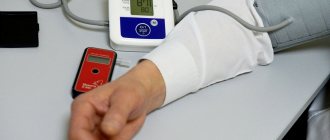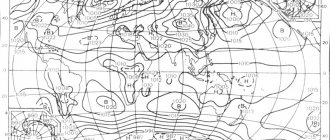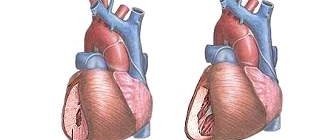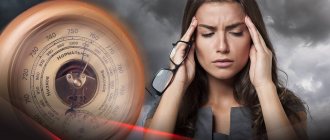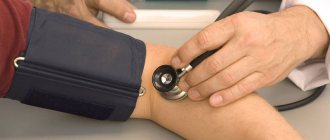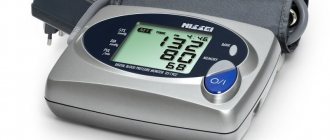The leading cause of cardiovascular mortality is arterial hypertension—the “disease of diseases.” The incidence of arterial hypertension in Russia is about 40%. The special insidiousness of hypertension is that, despite its danger, it does not greatly annoy a person. Unlike diseases, for example, joints, for which a person quickly consults a doctor and begins treatment, hypertension often goes unnoticed. Having started covertly, it constantly destroys target organs day after day: heart, brain, kidneys, eyes, blood vessels. A person often does not understand why his performance decreases, where emotional irritability comes from, a decrease in intelligence occurs, and vision deteriorates. And then everything can happen suddenly. Heart attack or stroke. Disability or mortality. How to control hypertension? How to prevent exacerbations and complications, maintain normal health and performance for many years?
What is hypertension?
The word hypertension is used to refer to persistently elevated blood pressure. An increase in blood pressure occurs when there is a narrowing of the arteries and/or their smaller branches, the arterioles. Arteries are the main transport routes through which blood is delivered to all tissues of the body. In some people, the arterioles often narrow, initially due to spasm, and later their lumen remains permanently narrowed due to wall thickening. And then, in order for the blood flow to overcome these constrictions, the work of the heart increases, more blood is released into the vascular bed. Hypertension develops. Very rarely, in approximately one in ten patients, the cause of increased blood pressure is damage to an organ. In these cases we talk about secondary or symptomatic hypertension. In the vast majority of cases, approximately 90% of patients, we are talking about so-called primary, or essential hypertension. Despite the fact that the cause of high blood pressure in these patients has not yet been fully established, there is no doubt that untreated hypertension is a serious threat to their health. The most common complications of hypertension are damage to vital organs such as the heart, brain and kidneys. The main symptom of arterial hypertension is high blood pressure (above 160/95 mm Hg), which may be accompanied by headache, dizziness, flashing before the eyes of spots, spots, circles, and decreased visual acuity. Pain in the heart area, a feeling of palpitations and interruptions in the functioning of the heart are possible. During an increase in pressure, a feeling of heat may occur, the face and other areas of the skin turn red, and then sweat appears on them. The limbs, on the contrary, tend to get cold. In later stages of the disease, symptoms of circulatory failure appear: blueness of the tip of the nose, fingers (acrocyanosis), swelling, shortness of breath during exercise, and eventually at rest. Other symptoms of arterial hypertension do not go unnoticed by the doctor: an increase in the size of the heart, a change in its tones when listening. As the disease progresses, signs of brain and kidney damage appear.
Diagnosis of arterial hypertension
To make a diagnosis, the therapist:
- Takes blood pressure measurements. Daily blood pressure monitoring using a portable device is indicated.
- Prescribes OAC, OAM and biochemical blood test. Of particular importance are the levels of hemoglobin, cholesterol, potassium, and creatinine).
- Gives a referral for an ECG to assess the functioning of the heart or for an ultrasound with Doppler ultrasound to examine the blood vessels.
- Gives a referral to an ophthalmologist to assess the condition of the fundus. Based on changes in blood vessels, the stage of hypertension can be determined.
- Assess kidney function based on ultrasound.
- Prescribes MRI of the brain for stroke.
Based on the results of the examinations, treatment is prescribed, lifestyle recommendations are given, or referrals are made for hospitalization.
Risk factors for developing hypertension
There are a number of conditions that influence the occurrence and development of hypertension. About sixty percent of adults have some risk factor for hypertension, and half of them have more than one factor, resulting in a significantly increased overall risk of the disease.
Heredity
Arterial hypertension in first-degree relatives (father, mother, grandparents, siblings) reliably means an increased likelihood of developing the disease. The risk increases even more if two or more relatives have high blood pressure.
Floor
Men are more predisposed to developing arterial hypertension, especially at the age of 35-50 years. However, after menopause, the risk increases significantly in women.
Age
High blood pressure most often develops in people over 35 years of age. The older a person is, the higher their blood pressure numbers tend to be.
Stress and mental strain
The stress hormone adrenaline causes the heart to beat faster, pumping more blood per unit of time, resulting in increased blood pressure. If stress continues for a long time, then the constant load wears out the blood vessels. Increased blood pressure becomes chronic.
Alcohol consumption
This is one of the main reasons for high blood pressure. Daily consumption of strong alcoholic drinks increases blood pressure by 5-6 mm. rt. Art. in year.
Atherosclerosis
Excess cholesterol leads to loss of elasticity in the arteries, and atherosclerotic plaques narrow the lumen of blood vessels, which makes it difficult for the heart to function. All this leads to increased blood pressure. However, hypertension, in turn, spurs the development of atherosclerosis, so these diseases are risk factors for each other.
Smoking
When components of tobacco smoke enter the bloodstream, they cause vasospasm. Not only nicotine, but also other substances contained in tobacco contribute to mechanical damage to the walls of the arteries, which predisposes to the formation of atherosclerotic plaques in this area.
Excess dietary sodium
Modern man consumes much more table salt with food than his body needs. Excess salt in the body often leads to spasm of the arteries, fluid retention in the body and, as a consequence, to the development of arterial hypertension.
Physical inactivity
People who lead a sedentary lifestyle are 20-50% more likely to develop hypertension than those who are actively involved in sports or physical labor. An untrained heart copes worse with stress, and metabolism is slower. In addition, physical activity helps cope with stress, while physical inactivity weakens the nervous system and the body as a whole.
Obesity
Overweight people have higher blood pressure than thin people. This is not surprising, since obesity is often associated with other listed factors - an abundance of animal fats in the diet (which causes atherosclerosis), consumption of salty foods, and low physical activity. It is estimated that every kilogram of excess weight means an increase in blood pressure by 2 mmHg.
If you have counted at least two risk factors, the risk of developing hypertension is already quite high. We advise you to pay attention to prevention and periodically be examined by a therapist or cardiologist.
Doctors say that the consequences of hypertension are more life-threatening than AIDS, cancer and tuberculosis combined. The insidiousness of this disease is that its symptoms are similar to signs of ordinary overwork. Therefore, approximately half of hypertensive patients find out about their disease too late, when it is very difficult to treat it and it is almost impossible to stop the processes of destruction of the body that it has started.
Jumps and jolts
Probably every adult has experienced surges in blood pressure. Usually we attribute them to unfavorable weather conditions, without even suspecting that these are actually harbingers of a dangerous disease - hypertension.
The heart is a kind of pump that pushes blood into the vessels.
Hypertension at the beginning of its development is associated with functional disorders of the activity of certain parts of the brain and autonomic nodes, which regulate the heart rate, the volume of blood expelled with each contraction, the lumen of blood vessels and their elasticity.
Doctors say that at this stage, the changes occurring in the body are still reversible if a person who notices high blood pressure consults a doctor.
Our blood pressure level is indicated by two numbers.
- The upper one, which is called systolic pressure , depends directly on the force with which the heart pushes blood into the vessels.
- And the lower one, which is called diastolic pressure , is determined by the elasticity of the walls of blood vessels and how firmly they hold the moving blood flow.
Danger signs
The danger of arterial hypertension is that it begins as a dysfunction of blood pressure regulation, but in the future it can lead to many serious diseases of internal organs and systems, as well as dangerous cardiovascular diseases.
Hypertension occurring without medical control can lead to:
- to a heart attack,
- heart enlargement
- and ultimately to heart failure.
Blood vessels may develop dilations or aneurysms that become vulnerable and often develop blockages.
As a result of increased pressure in the blood vessels, there is a risk of cerebral hemorrhage and stroke.
Hypertension can lead to:
- to renal failure,
- blindness
- and various cognitive impairments - decreased memory, intelligence and performance.
The consequences of hypertension are especially dangerous for those who have harmful factors added to the deadly effect on the body of high blood pressure -
- smoking,
- drinking alcohol,
- unhealthy diet,
- sedentary lifestyle,
- frequent stress,
- excess weight,
- very high cholesterol levels in the body
- and diabetes mellitus.
These people have an increased risk of heart attack, stroke, and kidney failure.
Live healthily
In order to prevent the development of hypertension and identify it at the initial stage, it is necessary to constantly keep blood pressure under control. And at the first alarm call, consult a doctor.
At the initial stage, you should not be afraid of the diagnosis of hypertension.
After all, some people just need to change their lifestyle and get rid of bad habits to normalize their blood pressure -
- quit smoking, alcohol,
- and sometimes even giving up salty foods and a diet that involves getting rid of extra pounds helps.
Since those who, in addition to hypertension, also have diabetes, are at particular risk, it is advisable for people suffering from these two diseases, in addition to constantly monitoring their blood pressure, to regularly check their blood sugar levels. After all, if such a combination of diagnoses becomes chronic, the risk of heart attack and stroke increases many times.
But still, it is better to prevent a disease than to treat it later.
And to minimize the risk, doctors give five useful tips:
- healthy eating - give up fast food, consume less than 5 g of salt per day (less than a teaspoon), eat five servings of fruit daily, reduce consumption of fats, especially unhealthy saturated fats;
- give up alcohol and smoking;
- increase your activity and exercise at least 30 minutes a day;
- get rid of extra pounds and control your weight, because losing excess body weight helps lower blood pressure;
- Try to have a positive attitude towards life and avoid stress.
By the way
- Normal blood pressure in adults is determined by levels of 120 mmHg when the heart contracts (systolic) and 80 mmHg when it relaxes (diastolic). It is considered elevated when the upper figure exceeds 140 and the lower figure exceeds 90 mm.
- In some parts of the modern world where there is almost no urbanization - in the settlements of the Australian aborigines, New Guinea and some Pacific islands - there are almost no patients with hypertension.
- Overweight people suffer from hypertension 3-4 times more often than those who are not overweight.
Source: https://www.aif.ua/
Cardiovascular diseases
2015 is the year of the fight against cardiovascular diseases.
In his annual Address to the Federal Assembly, Vladimir Putin stated, “this year (2014) ...
Arterial hypertension - basic concepts
High blood pressure, or hypertension, is considered the most common ser…
Sick heart: hidden signs
We are well aware of the signs of a heart attack: pain or pressure behind the sternum, shortness of breath, impaired r...
Stroke. Microstroke
A stroke, or as it was previously called, a brain stroke, is caused by a sudden cessation of blood supply...
How to recognize a stroke in time
Video Lesson. Signs of a stroke and first aid 3-6 hours. This is the time from the moment the first symptoms appear...
WHO. Prevention of heart attacks and strokes
Causes and conditions of heart attacks and strokes. What are the signs of heart attack and stroke and what...
Stop thrombosis, save lives
THROMBOSIS is the formation of a blood clot in an artery or vein; this is the same pathology that...
20 facts about the human heart
The human heart is a cone-shaped hollow muscular organ that receives blood from the...
Urgent self-help and mutual aid measures
In our country, up to 80% of deaths occur outside of medical organizations - at home, at work, in the countryside...
Risk factors for stroke. Should know this...
A stroke requires a lot of courage from the patient and a lot of patience and love from his loved ones. Because …
Stroke. The result is worth the effort
Sometimes the disorders caused by a stroke go away quickly, and after some time the person returns...
Stroke. The diagnosis will be made by a doctor
Currently, there are many basic and additional methods that allow you to deliver…
First aid for a heart attack (myocardial infarction)
Heart attack is one of the common causes of sudden death. No one is immune from it...
Cholesterol: what is it?
High cholesterol is a dangerous signal. Cholesterol is present in all tissues of the human body...
Prevention of hypertension
Preventing hypertension is a top priority for many people. Especially the act...
Hypertension is an epidemic of the 21st century. Questions and answers…
Hypertension, also known as high blood pressure, is a condition in which the blood...
October 29 is World Stroke Day...
Every year on October 29, the world celebrates World Stroke Day, which…
Pain in the heart area
Perhaps most people have experienced pain or other unpleasant sensations due to pain at least once in their lives...
Stroke. VIDEO
Heart attack. VIDEO
Consequences of hypertension
The higher your blood pressure, the harder the work your heart has to do to maintain normal blood circulation. Therefore, if hypertension is not treated, the walls of the heart first thicken or hypertrophy, which increases the risk of the heart working intermittently, and later the walls of the heart become thinner, which leads to disruption of the blood supply to the tissues and the heart itself and is accompanied by the appearance of shortness of breath, fatigue, and swelling in the legs. These signs often indicate the development of heart failure, which is the inability of the heart muscle to perform its normal pumping function.
High blood pressure accelerates a process known as atherosclerosis, which is the formation of fatty deposits on the walls of the arteries, causing them to harden, thicken, and reduce the lumen of the vessels. If the coronary arteries that supply blood to the heart are affected, angina pectoris or angina pectoris develops. As the process progresses, one of the arteries may become completely blocked, then part of the heart muscle stops receiving blood, and myocardial infarction develops. Atherosclerosis can affect any part of the arterial bed. If cerebral vessels are damaged, a patient with hypertension is highly likely to develop a cerebral stroke, which impairs motor abilities, speech and memory. When the blood vessels of the eyes, kidneys and lower extremities are affected, there is a high risk of developing blindness, renal failure and “intermittent claudication”.
Prognosis for hypertension
There is no complete recovery. However, modern treatment methods can slow the progression of hypertension, improve the quality of life of patients and avoid dangerous complications. The prognosis depends on the stage and nature of the disease. In a slowly occurring form, it is favorable; in stage II, serious consequences are possible (stroke, myocardial infarction), and in stage III, irreversible changes develop. Patients are forced to end their working career, become disabled and may be treated in a hospital for a long time. Hypertensive crises that cause strokes and cerebral disorders pose a great danger. The more often they occur, the worse the prognosis. No less important for the prognosis are changes in the kidneys, which determine life expectancy. Heart failure due to hypertension is also difficult to compensate for.
Prevention of hypertension development
Prevention of arterial hypertension is divided into primary and secondary. Primary prevention is needed for healthy people—those whose blood pressure does not yet exceed normal levels. The following set of health measures will help not only keep your blood pressure normal for many years, but also get rid of excess weight and significantly improve your overall well-being.
Physical exercise
Any physical exercise in persons with mild and moderate hypertension helps to increase physical performance. Exercises aimed at training endurance (general developmental exercises, breathing exercises, exercise equipment, swimming, walking, running) lead to a noticeable antihypertensive effect. However, during intense physical activity, systolic pressure increases sharply, so it is best to exercise a little (30 minutes) each day, gradually increasing the intensity from light to moderate.
Low salt diet
The amount of table salt should be limited to 5 grams (1 teaspoon) per day. It should be noted that many products (cheeses, smoked and pickled products, sausages, canned food, mayonnaise, chips) themselves contain a lot of salt. So remove the salt shaker from the table and never add salt to ready-made dishes. Replace salt with herbs and garlic. If it is difficult to do without salt, you can purchase salt with a reduced sodium content, the taste of which is almost no different from regular salt.
Limiting animal fats
Gradually replace butter, cheeses, sausages, sour cream, lard and fried cutlets from your diet with additional vegetables and fruits, vegetable oil and lean fish. Prefer low-fat dairy products. This way you can control cholesterol levels in the blood (prevention of atherosclerosis), normalize weight and at the same time enrich your diet with potassium, which is very useful for hypertension.
Rejection of bad habits
Enough has been said about the dangers of tobacco and alcohol. But if you find more than two of the risk factors for hypertension listed above, know that it’s time to be more merciful to your heart and blood vessels. Bad habits and arterial hypertension are a terrible combination, which in most cases leads to tragic consequences.
If the diagnosis of “hypertension” has already been made, a few more points should be added to the above measures. This is the so-called secondary prevention, the main task of which is to protect target organs from negative consequences and avoid the dangerous complications of hypertension - coronary heart disease, heart attack, cerebral stroke.
Psychological relief
Stress is one of the main causes of high blood pressure. That’s why it’s so important to master methods of psychological relief - auto-training, self-hypnosis, meditation. It is important to strive to see the positive sides in everything, to find joy in life, to work on your character, changing it towards greater tolerance for other people’s shortcomings, optimism, and balance. Hiking, sports, hobbies and spending time with pets also help maintain mental balance.
Blood pressure measurement
Blood pressure must be measured daily, and the resulting numbers must be written down in a special notebook, which must be shown to your doctor every 2-3 months. Secondary prevention of hypertension consists of individual selection of appropriate doses of antihypertensive drugs and systematic maintenance of normal or near-normal blood pressure values with their help.
Non-drug therapy
In addition to the already mentioned hypertensive diet, therapy may include breathing exercises, light massage, normalization of sleep, adherence to a daily routine, taking natural and synthetic vitamins, antioxidants, nutritional supplements and restorative herbs. In short, it’s worthwhile to “improve” your lifestyle as much as possible.
Non-drug treatments
Non-drug therapy for hypertension is a series of measures aimed at eliminating the unfavorable factors that cause the progression of the disease, as well as preventing possible complications of arterial hypertension.
Sign up for a checkup for hypertension
Make an appointment
Treatment of hypertension
Arterial hypertension cannot be left untreated. Normalizing high blood pressure can delay or even prevent serious illness. In past years, until the early 90s, hypertension was considered only as a problem of lowering blood pressure. Today it should be considered and treated in conjunction with risk factors for cardiovascular diseases. High blood pressure can be reduced without medication, especially in patients who are significantly overweight, heavy smokers and alcohol drinkers. But these cases are rare and are rather a happy exception, since the vast majority of patients require drug treatment.
